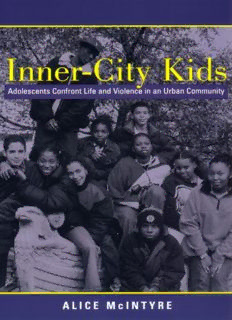
Inner City Kids: Adolescents Confront Life and Violence in an Urban Community (Qualitative Studies in Psychology) PDF
Preview Inner City Kids: Adolescents Confront Life and Violence in an Urban Community (Qualitative Studies in Psychology)
INNER-CITY KIDS QUALITATIVE STUDIES IN PSYCHOLOGY This series showcases the power and possibility of qualitative work in psy- chology. Books feature detailed and vivid accounts of qualitative psychol- ogy research using a variety of methods, including participant observation and field work, discursive and textual analyses, and critical cultural history. They probe vital issues of theory, implementation, representation, and ethics that qualitative workers confront. The series mission is to enlarge and refine the repertoire of qualitative approaches to psychology. GENERAL EDITORS Michelle Fine and Jeanne Marecek Everyday Courage: The Lives and Stories of Urban Teenagers by Niobe Way Negotiating Consent in Psychotherapy by Patrick O’Neill Voted Out: The Psychological Consequences of Anti-Gay Politics by Glenda M. Russell Inner-City Kids: Adolescents Confront Life and Violence in an Urban Community by Alice McIntyre ■ ■ ■ ■ ■ ■ ■ ■ ■ INNER-CITY KIDS Adolescents Confront Life and Violence in an Urban Community A L I C E M c I N T Y R E ■ ■ ■ ■ a New York University Press New York and London NEW YORK UNIVERSITY PRESS New York and London © 2000 by New York University All rights reserved Library of Congress Cataloging-in-Publication Data McIntyre, Alice, 1956– Inner-city kids : adolescents confront life and violence in an urban community / Alice McIntyre. p. cm. — (Qualitative studies in psychology) Includes bibliographical references and index. ISBN 0-8147-5635-2 (cloth : alk. paper) — ISBN 0-8147-5636-0 (pbk. : alk. paper) 1. Urban youth—United States—Attitudes. 2. Inner cities—United States. 3. Social work with youth—United States. 4. Children and violence—United States. I. Title. II. Series. HQ796 .M237 2000 305.235'0973'091732—dc21 00-010317 New York University Press books are printed on acid-free paper, and their binding materials are chosen for strength and durability. Manufactured in the United States of America 10 9 8 7 6 5 4 3 2 1 ■ ■ ■ ■ ■ ■ ■ ■ ■ This book is dedicated to Clara Beatrice Lawton May you grow up in a just society where your dreams will not be deferred due to the color of your skin. Where you can live freely and unafraid. Where you can walk the streets and know, believe, and be assured that Black is truly beautiful. ■ ■ ■ ■ ■ ■ ■ ■ ■ “It isn’t funny. . . . Take it back. Call that story back,” said the audience by the end of the story, but the witch answered: “It’s already loose/It’s already coming./It can’t be called back.” A story is not just a story. Once the forces have been aroused and set into motion, they can’t simply be stopped at someone’s request. Once told, the story is bound to circulate; humanized, it may have a temporary end, but its effects linger on and its end is never truly an end. —T. T. Minh-Ha, Woman, Native, Other: Writing Postcoloniality and Feminism Contents ■ ■ ■ ■ Acknowledgments xi Introduction 1 1. Participatory Action Research 13 2. Exploring Community 34 3. Constructing Meaning about Violence 58 4. Community Photography: Visual Stories by Inner-City Youth 93 5. Becoming Somebody 123 6. Exploring Racism, Whiteness, and Careers with Urban Youth 146 7. From Dialogue to Action 167 8. Making the Road As We Go 196 Appendix A: Transcription Code 213 Appendix B: Community Resource Inventory—Youth 214 Notes 217 References 221 Index 235 About the Author 243
Description: